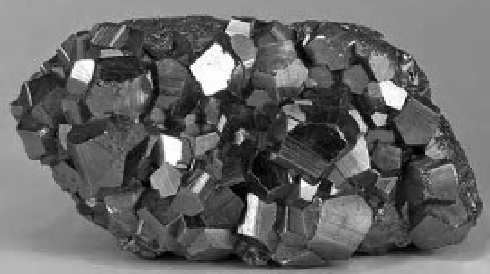Geoscience Reference
In-Depth Information
Figure 10-4.
Oxygen concentration in Gulf of Mexico, southern Louisiana and southeastern Texas (see Color Plate
10-4). 2006 Seamap hypoxia map overlaid with June 2006 chlorophyll OC3 MODIS-derived image. Red and orange
colors indicate hypoxic conditions in coastal waters. A. New Orleans, B. Mississippi River delta. Adapted from NASA
(2010a).
Figure 10-5.
Pyrite crystals on massive pyrite. Specimen measures
∼
8
×
4 cm; from Eagle County, Colorado.
Adapted from original photo by R. Lavinsky; obtained from Wikimedia Commons
<
>
http://commons.wikimedia.org/
.
Gammaproteobacteria, thrived and reproduced
when fed an arsenic-rich solution (Wolfe-Simon
et al. 2010). This remarkable wetland discovery
has major implications for understanding the
chemical basis of life as well as the possibility
of life on other worlds.
Potassium and sulfur are generally abundant
in wetland environments and are not likely
to be limiting factors for plant growth. In the
anaerobic zone, sulfur and sulfate are reduced
by
Desulphovibrio
bacteria into hydrogen suli de
(H
2
S), which gives the distinctive smell of swamp
or marsh gas, or to solid iron suli des, depend-
ing on the presence of iron (Charman 2002). On
the other hand, hydrogen suli de may be oxi-
dized under aerobic conditions by
Thiobacillus
bacteria into iron sulfate or sulfuric acid. The
latter augments the acidity of many wetlands,
particularly after suli de-rich peatlands are
drained (Charman 2002). Iron suli des are quite
dark and give the black color typically seen
in anaerobic soils. One common iron-suli de
mineral is pyrite (FeS
2
), popularly known as
fool's gold (Fig. 10-5). Pyrite is often found in






